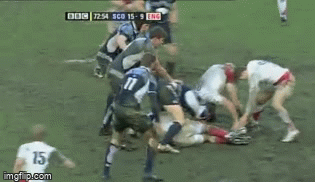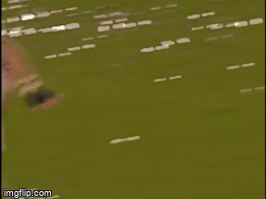Former Scotland, Lions, Sale and Clermont hitman talks through his favourite tackles
Jason White relives his biggest hits
“I SOMETIMES look back and think, ‘God, did I actually do that?'” offers Jason White.
Once known as the hitman of Scottish rugby, the former Caley, Sale, Clermont and Lions six has an impressive back catalogue of big tackles. Ask him for his favourites and he can recall them in great detail.
So here is a smash down memory lane as he talks us through his greatest hits.
On Jerry Flannery, 2006

Last year, on an episode of Joe‘s House of Rugby, Jerry Flannery described this hit, saying that White “absolutely maimed me!”
Describing how then-Ireland boss Eddie O’Sullivan warned his players not to carry around the corner, Flannery continued: “And, honestly man, someone carried and didn’t make much of a f****** gain but I was like, ‘Oh, I’m going to show Eddie’ and then, as I was getting the ball it was just like, ‘Oooh, my soul has been taken away from me!’
“And, literally, someone shouted to me, when I was on the ground, ‘Are you still alive?!’ I was like ‘Ughhh.'”
Giving his perspective on the hit against Ireland, White says: “It’s about trying to get into position early. You scan up and see what’s in front of you. For the one on Jerry It was obvious that Ireland were coming around the corner. And he’s running but it’s obvious that he was the only option I could see – he is the only person who is going to get the ball.
“From there I’m set. And as soon as the balls come off from the nine at the base of the ruck I’ve got off that line really quickly, I’ve got to have really good line speed. I was gonna go to him and there’s no other options, there weren’t any good decoys. There weren’t two runners there and it didn’t look like Jerry was gonna tip the ball on.

Another hit: Flannery carries into contact in 2006 (Inpho)
“I would always try to hit with the point of my shoulder. As opposed to some who will chuck their arm in really hard. You just try to transfer the power through your legs and through your shoulder and just tried to hit him at the midriff, and then if you can, try to hook a leg – it was Alan Tait who would talk about ‘handles’ from his rugby league days.”
In the end, he goes for the hook and is grabbing for the hooker, but he hits Flannery so hard he is cannot keep hold.
According to White, it is possible to get caught ‘man-watching’ as Jacques Burger describes in our recent piece on defensive detail, but for White, while you can miss the odd shot it is about commitment.
Related: Where rugby defences and Dennis Rodman converge
With this one, Flannery turned in to catch the ball too, exposing his side, with White adding: “That’s exactly what you want, that’s dream stuff.
“I was able to get up and get him man and ball. You can get somebody who can just glance off or give you like a little hip-check like some of the bigger people – Louis Picamoles was really hard. Jamie Roberts was hard. Because they were very strong around the hip and bum area. The slightest little bit of movement from them coming off was really gonna make a difference, because you can’t put a shot on them clean.”
On Paul Sackey, 2008

“I was on as a subby here,” recalls White, now head of sport at Loretto school. “Coming off the bench it’s about what can you do to bring some energy to the team and I probably waited to make my mark.
“It’s a one off-runner. Just nobody with him (Sackey) at all. The pitch was probably a little bit heavy, it’s 72 minutes and there’s no decoy, there’s nobody else with him there. So you just get off the line and I managed to drive him up and backwards for it.
“Some of the wingers can be the biggest and most powerful people on the pitch and Sackey was a great athlete, but he wasn’t the big thundering winger that you can have. That was winning that physical contest, with aggression and line speed again.
“Shot selection was really important. And obviously, if someone’s on your side (past the gainline), you’re just on a classic tackle on the side, get them on the ground. Sometimes if you’ve not won the contest, you almost need to speed bump them and let them take them themselves down (in a soak tackle). It’s just getting a feel for it and at that point, I would probably have learned my craft a little bit. That was 2008 so I’d been a pro for ten years.
“So I’d made mistakes and learnt what to identify and you just you get that feel for when you can tackle. ‘Can I dominate this guy or am I on a hiding to nothing?’ And I would probably back myself under favourable conditions for most of them. But you need to weigh it all up and see what’s going to be the best success for the team.”
On Trevor Woodman, 2004

“This is just before half-time. I was putting some cracking tackles in a club level but this was probably the first really big shot I’d put in at international level.
“I came from far out, I was probably defending at 13, and I came in and properly halved him. He managed to regather it and I remember one of my ribs, the top of my rib must have popped out and I remember going off at half-time struggling to breath. Will Greenwood came up, tapped me on the bum and made some comment about what a cracking tackle that was.
“He didn’t see me coming so it was the classic, out-to-in one, he only sees the ball and can’t see the defender from the outside channel coming in to get him. I managed to steal a bit of an advantage on him.”

Teamwork: White and Tom Philip double-tackle Yannick Jauzion, 2004 (Getty Images)
Is there an art to knowing where to come from in the defensive line at certain stages of a game?
White gives his view: “Everyone does need to be able to defend anywhere but it will be obvious that your front five, as a generalisation, will be closer to the breakdown. It’s about having empathy, working with your defence coach. I probably ended up in that 13 channel because we were getting stretched by England. It’s reacting and believing in yourself that you can execute the skill properly.”
On Michael Owen, 2006
“That was Millennium Stadium and again I was on the bench,” White says of his hit on Wales No 8 Michael Owen, shown in the image at the top of this piece.
“I just went absolutely all in. Michael took the ball absolutely flat out and I hit him horizontal. Before he got the ball I was already horizontal. If he had deviated by about three inches I would probably have been sparked (out, concussed). So the timing came off and Michael’s a big, big dude and I absolutely cut in half, to be honest.
“I was a little bit fortunate but there was an element of risk and reward there, I went for it and it came off.”

Another hit that day: Robert Sidoli gets the White treatment too (Getty Images)
The main image shows a big hit at the midriff. White is 6ft 5in. As debate swirls around tackle height in the current game, the former flanker can offer his observations.
“It’s about technique and it’s your ability to understand and use your body,” White says. “There is a big thing there that’s down to shot selection. If your team’s defensive coach is looking for lots and lots of line speed and you’re pushing out really hard, it can then be difficult to get your body down low, to execute a low tackle. You can end up almost chest on chest because teams are playing really tight to the gainline.
“Attacks nowadays are a little bit more inventive. You’ve got all the back plays and the ball carriers are good enough to hit the people in front or they can play out the back. That’s where you’ve got real big line speed. That’s when it can be harder. But you can get down low, definitely.
“I think the biggest thing is, is getting your head on the right side. You want to be hitting around the soft part of the upper thigh probably. My dad always told me ‘You can’t run without your ankles!’

Hard to hit: White and Co faced Lomu in 2000 (Getty Images)
“Get your head on the right side and hit with your shoulder. That for me was always the most important thing. Then I think timing becomes key. The hardest guy to tackle ever for me – probably for a lot of people – was Jonah Lomu because his stride length was so great.
“When he was into his full cadence, you couldn’t tackle one leg because it’s so big. So you had to make sure you could get your timing correct. When both legs were together, you tried to knock his knees together. The chat I use when I’m coaching is the old ‘foot in the hoop, cheek to cheek, band of steel.’ You just to make sure that your foot is in there close, you drive through your shoulder and you need to wrap your arms around as hard as you can.”
The hard work on his skills paid off and White says he was fortunate to live out his boyhood dreams. For so many others, running down his channel was a nightmare.
Can’t get to the shops? You can download the digital edition of Rugby World straight to your tablet or subscribe to the print edition to get the magazine delivered to your door.
Follow Rugby World on Facebook, Instagram and Twitter.





